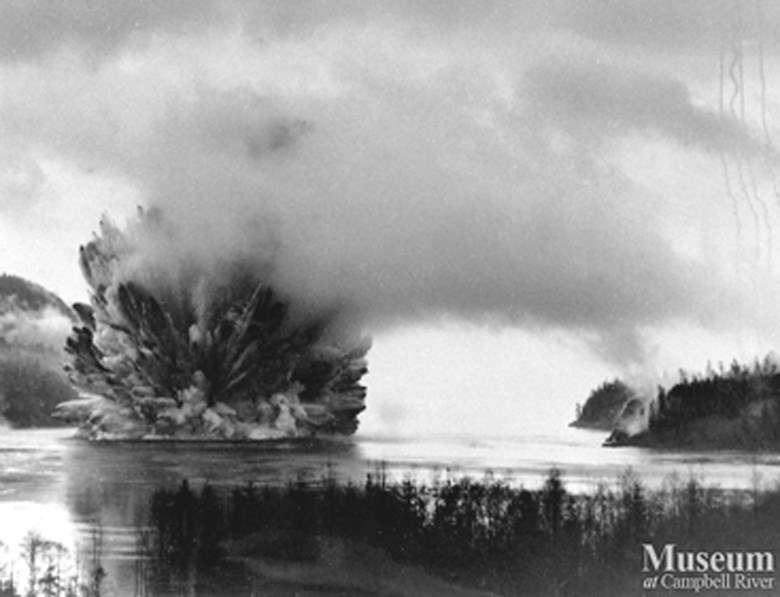In 1958, we were not quite as sentimental about geography as we are today.
On this date in that year, Canada blew up a mountain in what was, up to that time, the world’s largest peacetime non-nuclear explosion.
The underwater mountain, dubbed Ripple Rock, near Campbell River B.C., had two peaks just nine feet below the surface at low tide that had always been a menace to mariners trying to navigate the trade route from Vancouver to northern ports. The explorer George Vancouver described the Seymour Narrows, where the peaks resided, as “one of the vilest stretches of water in the world.”
Between 1875 and 1958, Ripple Rock claimed 20 large and 100 smaller vessels and 110 lives.
The danger was not just running aground, but perilous eddies that created strong tidal currents around “Old Rip,” which it was not-so-affectionately called.
Blowing up the mountain was a big, big event. In fact, it is now one of 473 officially recognized National Historic Events.
It took two-and-a-half years of 75 men working around the clock in three shifts to plant the 1,270 tonnes of Nitramex 2H—a stable compound based on ammonium nitrate—required to create the explosion.
That was achieved by drilling a 500-ft vertical shaft into Maud Island then a 2,370 foot horizontal shaft into the core of Ripple Rock. From there, vertical shafts were extended into the two peaks with “coyote” shafts to house the explosives.
In all, it cost nearly $3 million ($25 million it today’s dollars), was one of the first live events televised coast to coast on CBC Television, and moved 635,000 tonnes of rock and water increasing low tide clearance to 45 feet.
No thought was given to the potential environmental impacts of the plan, of course, but atomic weapons researchers from around the world traveled to the site to study the explosion.
The big news in Yorkton that week paid only passing tribute to the 41st anniversary of the Canadian Corps exploits at Vimy Ridge.
April 9.—Vimy Day, 1958, is likely to go down in the records as the scene of the most daring series of robberies in this town’s 50-year history,” the top story in the April 10 1958 edition of The Enterprise began. “And the entire series of crime was executed by one man and one man quite alone. He had spent only two days in town and never was here before, but this good looking young fellow, known in his home town of Kenora, Ont., as Ally Raynard, in the brief spell 70 minutes, robbed in sensational manner, 15 snipers in Yorkton livery, not only one apiece, but on innumerable occasions.”
This somewhat purple and melodramatic example of prose prefaced a hockey story. Mr. Raynard was the goalie for the visiting Kenora Thistles playing a tight Western Canada semi-final playoff series with the Yorkton Millers. His robberies were, in fact numerable, as evidenced later in the article.
“The fact that Yorkton fired no less than 46 shots at Ally Raynard, and only one of them got by him, will best indicate his terrific performance. The Thistles had 35 direct shots on the Yorkton citadel, with only one of them resulting in a red light.”
After a 10-minute overtime, the game ended in a 1-1 tie, keeping the five-game series even at one win apiece with two ties.
The Millers would be relegated to Page 12 the following week after falling 2-0 in the fifth game to be denied a berth in the championship series.
A big controversy at the time was apparently liquor advertising. In Manitoba and Saskatchewan at that time, it was illegal to advertise alcoholic beverages in provincial publications. That gave national magazines and newspapers sold in the prairies a huge advantage having access to one of the most lucrative client-bases in the country, the manufacturers of said products.
The Enterprise was not taking it lying down. In an editorial April 10, 1958, the editors attacked the provincial legislatures and the United Church advocating “equal rights for all” in the liquor advertising, realm.
“While we are well aware of the serious damage done to the health and moral equilibrium of our people by alcohol, we can find no reason for the United Church and the governments of Manitoba and Saskatchewan taking the stand they do in marshalling so much of their effort against the newspapers. A ban on liquor advertising is certainly not going to either eliminate or diminish the sale of liquor. If those who are really sincere in wanting to rid the land of alcohol, why do they not campaign against its sale or manufacture? Why doesn’t the United Church insist on depriving the C.C.F. government of Saskatchewan of $10,000,000 profit from the sale of liquor a year instead of depriving many newspapers of the margin of profit they require to stay in business.”




